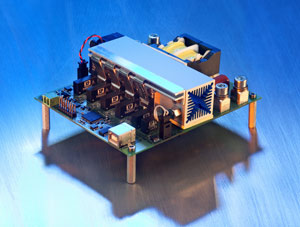Modern power transistors based on gallium nitride (GaN) enable power electronic switches to operate at much higher switching frequencies compared with those based on silicon (Si). Advantages include increased power density per volume and per weight, reduced costs, lower material use and, in the case of a mobile system, increased system efficiency. Solutions and concepts for such high-frequency power electronics of the future are to be developed in the three-year collaborative project 'GaN-resonant – Efficient, highly compact high frequency power electronics with GaN transistors', which is being funded (since project launch on 1 July) by about €1.2m from the German Federal Ministry for Education and Research (BMBF) in the context of its funding announcement 'Leistungselektronik zur Energieeffizienzsteigerung (Power Electronics for Increasing Energy Efficiency)'.

Picture: Laboratory prototype of DC/DC converter with GaN power
Project partners in the consortium are Fraunhofer Institute for Solar Energy Systems ISE, SUMIDA Components & Modules GmbH, and Liebherr Elektronik GmbH.
The project's goal is to use GaN transistors to develop a resonant DC/DC converter, operating at switching frequencies well above 1MHz with nominal power of 3kW. The simultaneous achievement of extremely high switching frequencies and high transmitted power requires the use of innovative inductive components, says Fraunhofer ISE, and the development of such devices comprises a significant part of the collaborative project. Due to high power losses, the solutions available currently limit the practical switching frequency. Existing solutions are hence unsuitable for future applications, which demand both a substantially higher power density and a higher efficiency at the same time. This can only be realized by innovations in inductive components (core materials and geometries, winding structures and cooling concepts).
In the area of control, synchronous to the applied switching frequency, new problems arising due to the higher frequencies will be addressed by the project. Such issues include, for example, broadband data acquisition and signal processing. To exploit the advantages of a high switching frequency, the computing power used to control the DC/DC converter must be increased by a similar amount, as the switching frequency or parts of the control must be performed by analog devices.
A possible application for the resonant voltage converter under development is aeronautical electronics, for which compactness and low weight are of the utmost importance. The amount of harmful emissions (which are of particular concern especially at high elevations) can be reduced by decreasing the system's weight. Due to higher power density, the electronics technology is well suited to other mobile applications, for which low space requirements, low cooling demand and low weight are decisive criteria.
Another application is in power supplies for server farms or communication electronics in general. Currently, global energy consumption for communications infrastructure has reached immense proportions. In addition to saving material, the technology can also reduce power loss. This leads not only to increased efficiency but also to lower cooling demands, says Fraunhofer ISE.
The project partners Fraunhofer Institute for Solar Energy Systems ISE, SUMIDA Components & Modules GmbH and Liebherr Elektronik GmbH note that they complement each other due to their various areas of expertise in power electronics, inductive devices and aeronautical electronics.





